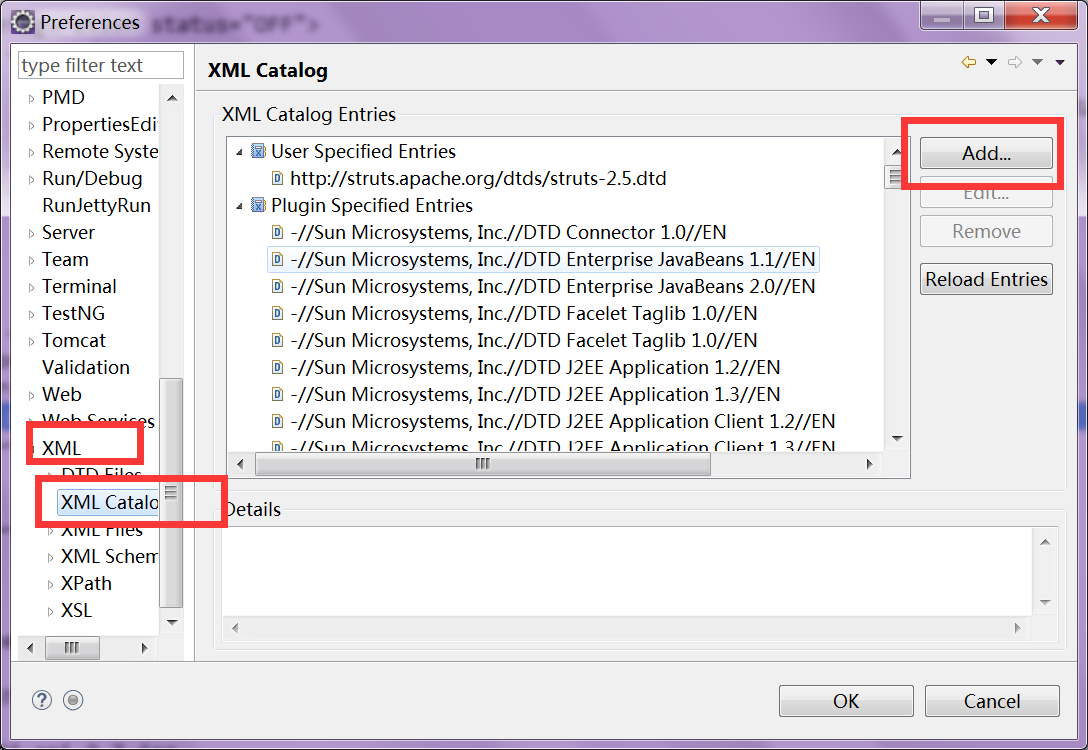简介
1、Apache Struts的前世今生
- Apache Struts 1 实在2009前应用广泛的web开发框架(最后一个版本是1.3.10)
- Apache Struts 2是在Apache 在webwork基础上重新开发出来的新一代web开发框架,在目前的Apache Struts 2框架中依然有 webwork的印记:xwork2包
2、Apache Struts 2的执行流程:

- 客户端发出请求到web服务器
- 请求经过一系列filter,最终到达Struts2核心控制器
- 核心控制器查看ActionMapper,判断该请求是请求action还是其他资源(如:jsp页面文件)
- 如果请求action,则核心控制器创建一个ActionProxy代理,并把请求交给代理进行处理。ActionProxy是通过ConfigurationManager读取structs.xml配置文件来创建的,所以包含了配置文件中的一切信息
- ActionProxy根据请求,创建相应的action调用实例ActionInvocation,ActionInvocation实例不仅仅只有action对象,还包括在配置文件中配置好的拦截器、action实例、结果集等
- 依次执行ActionInvocation实例中的拦截器、action实例,返回result,根据result决定响应页面,倒序继续执行拦截器剩下的部分,最终通过response进行响应,返回客户端
3、由上面可知Struts2开发需要用到:
- 处理请求的Action类以及拦截器类
- 配置Action、拦截器、结果响应行为等的struts.xml
- 在web.xml中配置核心控制器
搭建环境
1、创建 动态的 WEB 工程
2、在 WEB-INF/lib 中添加,下载链接:https://files.cnblogs.com/files/AmyZheng/struts-2.5.10.1-min-lib.zip
commons-fileupload-1.3.2.jar
commons-io-2.4.jar
commons-lang3-3.4.jar
freemarker-2.3.23.jar
javassist-3.20.0-GA.jar
log4j-api-2.7.jar
ognl-3.1.12.jar
struts2-core-2.5.10.1.jar
3、在 web.xml 中部署 Struts 对应 过滤器
<?xml version="1.0" encoding="UTF-8"?> <web-app xmlns:xsi="http://www.w3.org/2001/XMLSchema-instance" xmlns="http://java.sun.com/xml/ns/javaee" xsi:schemaLocation="http://java.sun.com/xml/ns/javaee http://java.sun.com/xml/ns/javaee/web-app_3_0.xsd" id="WebApp_ID" version="3.0"> <!-- 配置 Struts 过滤器 --> <filter> <filter-name>ApacheStruts2</filter-name> <filter-class>org.apache.struts2.dispatcher.filter.StrutsPrepareAndExecuteFilter</filter-class> </filter> <filter-mapping> <filter-name>ApacheStruts2</filter-name> <url-pattern>/*</url-pattern> </filter-mapping> </web-app>
注意:
Struts 2.5 开始使用org.apache.struts2.dispatcher.filter.StrutsPrepareAndExecuteFilter
在Struts 2.5 之前使用org.apache.struts2.dispatcher.ng.filter.StrutsPrepareAndExecuteFilter
4、验证 Struts 已经起作用
<%@ page language = "java" pageEncoding = "UTF-8" %>
<%@ page contentType = "text/html; charset= UTF-8"%> <%@ taglib prefix = "s" uri = "/struts-tags"%> <!DOCTYPE html> <html> <head> <meta charset="UTF-8"> <title>Apache Struts</title> </head> <body> <h1>Apache Struts</h1> <s:debug /> </body> </html>
第一个实例
1、开发一个Action
- 可以实现 com.opensymphony.xwork2.Action 接口,实现execute 方法
- 可以继承 com.opensymphony.xwork2.ActionSupport类,重写execute 方法
- 可以单独写一个类,其中有一个execute方法即可:
package ecut.first.action; public class RegistAction { private String username ; private String password ; private String confirm ; private char gender ; public String execute() throws Exception { System.out.println( "username : " + username ); System.out.println( "password : " + password ); System.out.println( "confirm : " + confirm ); System.out.println( "gender : " + gender ); return "成功" ; } public String getUsername() { return username; } public void setUsername(String username) { this.username = username; } public String getPassword() { return password; } public void setPassword(String password) { this.password = password; } public String getConfirm() { return confirm; } public void setConfirm(String confirm) { this.confirm = confirm; } public char getGender() { return gender; } public void setGender(char gender) { this.gender = gender; } }
2、在src目录下新建 struts.xml(必须在src目录底下)
参照struts2-core-2.5.10.1.jar中struts-2.5.dtd中的说明编写struts.xml

让Eclipse支持struts.xml的智能提示,将dtd文件复制到容易查找的目录下,在Eclipse的导航选择Widow下的preferences,选择如下目录

点击Add,显示如下页面,Key Type选择URI

Location 选择dtd文件所在路径,Key填入http://struts.apache.org/dtds/struts-2.5.dtd

<?xml version="1.0" encoding="UTF-8"?> <!DOCTYPE struts PUBLIC "-//Apache Software Foundation//DTD Struts Configuration 2.5//EN" "http://struts.apache.org/dtds/struts-2.5.dtd"> <struts> <!-- first --> <!-- @WebServlet( "/customer/regist" ) --> <!-- 用 name 属性 指定 package 的名称 , 用 namespace 指定命名空间,必须 用 extends 指定继承哪个包 --> <package name="customer" namespace="/customer" extends="struts-default"> <action name="regist" class="ecut.first.action.RegistAction" method="execute"> <result name="成功">/first/success.jsp</result> <result name="失败">/first/fail.jsp</result> </action> </package> </struts>
struts 标签是配置文件的根元素
package 标签用来声明一个“包”(不是Java语言中的包)
name 属性用来指定报名通常建议跟namespace保持一致
namespace属性用来指定命名空间,与URL中的路径保持一致
extends属性用来指定继承那个包(只能继承一个包)
action 标记定义个action
name属性与URL中的对应
class属性指定该action 对应的Action类(ActionClassName)
result 标记是action内部的一个子标记,用来声明返回的结果
name属性指定将来在Action类中的execute方法返回的结果的名称
(name属性的默认值是"success")
type属性用来指定打开结果对应页面或资源的方式,默认是dispatch
(相当于Servlet 中 RequestDispatch#forward操作)
3、提供页面,访问已经配置好的Action
<%@ page language = "java" pageEncoding = "UTF-8" %>
<%@ page contentType = "text/html; charset= UTF-8"%> <%@ taglib prefix = "s" uri = "/struts-tags"%> <!DOCTYPE html> <html> <head> <meta charset="UTF-8"> <title>Apache Struts</title> </head> <body> <h1>Apache Struts</h1> <a href="http://struts.apache.org">Apache Struts</a> <br> <a href="http://commons.apache.org">Apache Commons</a> <br> <form action="${ pageContext.request.contextPath }/customer/regist" method="post" > <input type="text" name="username" placeholder="用户名"> <input type="password" name="password" placeholder="密码"> <input type="password" name="confirm" placeholder="确认密码"> 性别: <input type="radio" name="gender" value="女" >女 <input type="radio" name="gender" value="男" >男 <input type="submit" > </form> <hr> <s:debug /> </body> </html>
<%@ page language = "java" pageEncoding = "UTF-8" %>
<%@ page contentType = "text/html; charset= UTF-8"%> <!DOCTYPE html> <html> <head> <meta charset="UTF-8"> <title>注册失败</title> </head> <body> <h1>fail</h1> </body> </html>
<%@ page language = "java" pageEncoding = "UTF-8" %>
<%@ page contentType = "text/html; charset= UTF-8"%> <!DOCTYPE html> <html> <head> <meta charset="UTF-8"> <title>注册成功</title> </head> <body> <h1>success</h1> </body> </html>
4、启动Tomcat,输入http://localhost:8080/Struts/first/index.jsp,跳转success页面


添加对log4j的支持
1、 解决启动服务日志中两个问题
解决:
ERROR StatusLogger Log4j2 could not find a logging implementation. Please add log4j-core to the classpath. Using SimpleLogger to log to the console...
在WEB-INFO/lib目录下贴加:log4j-core-2.7.jar
解决:
ERROR StatusLoggVer No log4j2 configuration file found. Using default configuration: logging only errors to the console.
src 目录创建 log4j2.xml 文件
2、 log4j2 日志组件的使用
- log4j2 是 Apache 提供的 日志组件 ( Struts 2 中默认采用了 该组件 )
- 提供 log4j2 所必须的 jar 文件:log4j-api-2.7.jar, log4j-core-2.7.jar
- 提供 log4j2 配置文件,在 WEB 工程的 src 目录创建 log4j2.xml 文件,其中内容如下:
<?xml version="1.0" encoding="UTF-8"?> <configuration status="OFF"> <appenders> <console name="Console" target="SYSTEM_OUT"> <PatternLayout pattern="%d{HH:mm:ss.SSS} [%t] %-5level %logger{36} - %msg%n" /> </console> </appenders> <loggers> <!-- 指定日志的级别 --> <root level="trace" > <appender-ref ref="Console" /> </root> </loggers> </configuration>
日志的级别可以指定为 all 、 trace 、debug 、info 、warn 、log 、error 、fatal 、off 中的任意一个
按照优先级从低到高依次排列为: all < trace < debug < info < warn < log < error < fatal < off
优先级越低,输出的内容越多;优先级越高,输出的内容越少。 - 在相应的类中使用 log4j2 输出日志:
package ecut.first.logger.test; import org.apache.logging.log4j.Level; import org.apache.logging.log4j.LogManager; import org.apache.logging.log4j.Logger; public class Log4j2Test { private static final Logger logger = LogManager.getLogger(); public static void main(String[] args) { logger.log( Level.ALL , "all message" );// Level.ALL logger.trace( "trace message" ); // 对应 logger.log( Level.TRACE , message ); logger.debug( "debug message" ); // 对应 logger.log( Level.DEBUG, message ); logger.info( "info message" ); // 对应 logger.log( Level.INFO, message ); logger.warn( "warn message" ); // 对应 logger.log( Level.WARN, message ); logger.error( "error message" ); // 对应 logger.log( Level.ERROR, message ); logger.fatal( "fatal message" ); // 对应 logger.log( Level.FATAL , message ); logger.log( Level.FATAL , "FATAL" ); logger.log( Level.OFF , "off message" );// Level.OFF } }
<PatternLayout pattern="%d{yyyy-MM-dd HH:mm:ss.SSS} [%t] %p %l - %m %n" />
模式转换字符:
转换字符 表示的意思
c 用于输出的记录事件的类别。例如,对于类别名称"a.b.c" 模式 %c{2} 会输出 "b.c"
C 用于输出呼叫者发出日志请求的完全限定类名。例如,对于类名 "org.apache.xyz.SomeClass", 模式 %C{1} 会输出 "SomeClass".
d 用于输出的记录事件的日期。例如, %d{HH:mm:ss,SSS} 或 %d{yyyy-MM-dd HH:mm:ss.SSS}
F 用于输出被发出日志记录请求,其中的文件名
l 用于将产生的日志事件调用者输出位置信息
L 用于输出从被发出日志记录请求的行号
m 用于输出使用日志事件相关联的应用程序提供的消息
M 用于输出发出日志请求所在的方法名称
n 输出平台相关的行分隔符或文字
p 用于输出的记录事件的优先级
r 用于输出毫秒从布局的结构经过直到创建日志记录事件的数目
t 用于输出生成的日志记录事件的线程的名称
x 用于与产生该日志事件的线程相关联输出的NDC(嵌套诊断上下文)
X 在X转换字符后面是键为的MDC。例如 X{clientIP} 将打印存储在MDC对键clientIP的信息
% 文字百分号 %%将打印%标志
参考博客链接:
http://www.cnblogs.com/ygj0930/p/6807539.html
转载请于明显处标明出处